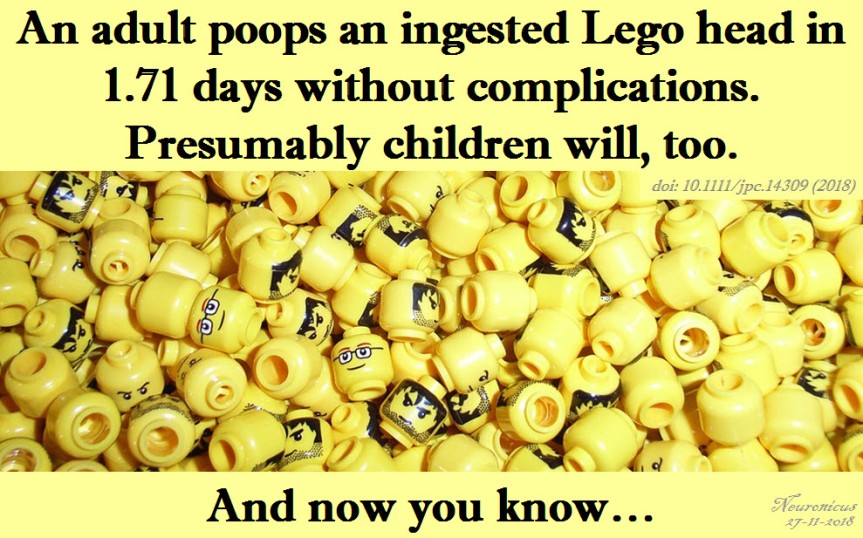Yeah, alright… uhm… how exactly should I approach this paper? I’d better just dive into it (oh boy! I shouldn’t have said that).
The authors of this paper were adult health-care professionals in the pediatric field. These three males and three females were also the participants in the study. They kept a poop-diary noting the frequency and volume of bowel movements (Did they poop directly on a scale or did they have to scoop it out in a bag?). The researchers/subjects developed a Stool Hardness and Transit (SHAT) metric to… um.. “standardize bowel habit between participants” (p. 1). In other words, to put the participants’ bowel movements on the same level (please, no need to visualize, I am still stuck at the poop-on-a-scale phase), the authors looked – quite literally – at the consistency of the poop and gave it a rating. I wonder if they checked for inter-rater reliability… meaning did they check each other’s poops?…
Then the researchers/subjects ingested a Lego figurine head, on purpose, somewhere between 7 and 9 a.m. Then they timed how much time it took to exit. The FART score (Found and Retrieved Time) was 1.71 days. “There was some evidence that females may be more accomplished at searching through their stools than males, but this could not be statistically validated” due to the small sample size, if not the poops’. It took 1 to 3 stools for the object to be found, although poor subject B had to search through his 13 stools over a period of 2 weeks to no avail. I suppose that’s what you get if you miss the target, even if you have a PhD.
The pre-SHAT and SHAT score of the participants did not differ, suggesting that the Lego head did not alter the poop consistency (I got nothin’ here; the authors’ acronyms are sufficient scatological allusion). From a statistical standpoint, the one who couldn’t find his head in his poop (!) should not have been included in the pre-SHAT score group. Serves him right.
I wonder how they searched through the poop… A knife? A sieve? A squashing spatula? Gloved hands? Were they floaters or did the poop sink at the base of the toilet? Then how was it retrieved? Did the researchers have to poop in a bucket so no loss of data should occur? Upon direct experimentation 1 minute ago, I vouchsafe that a Lego head is completely buoyant. Would that affect the floatability of the stool in question? That’s what I’d like to know. Although, to be fair, no, that’s not what I want to know; what I desire the most is a far larger sample size so some serious stats can be conducted. With different Lego parts. So they can poop bricks. Or, as suggested by the authors, “one study arm including swallowing a Lego figurine holding a coin” (p. 3) so one can draw parallels between Lego ingestion and coin ingestion research, the latter being, apparently, far more prevalent. So many questions that still need to be answered! More research is needed, if only grants would be so… regular as the raw data.
The paper, albeit short and to the point, fills a gap in our scatological knowledge database (Oh dear Lord, stop me!). The aim of the paper was to show that ingested objects by children tend to pass without a problem. Also of value, the paper asks pediatricians to counsel the parents to not search for the object in the faeces to prove object retrieval because “if an experienced clinician with a PhD is unable to adequately find objects in their own stool, it seems clear that we should not be expecting parents to do so” (p. 3). Seems fair.

REFERENCE: Tagg, A., Roland, D., Leo, G. S., Knight, K., Goldstein, H., Davis, T. and Don’t Forget The Bubbles (22 November 2018). Everything is awesome: Don’t forget the Lego. Journal of Paediatrics and Child Health, doi: 10.1111/jpc.14309. ARTICLE
By Neuronicus, 27 November 2017


